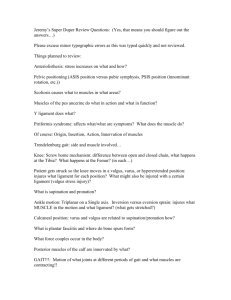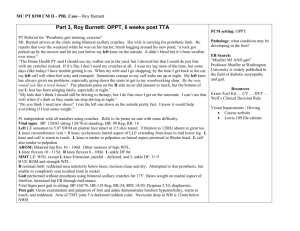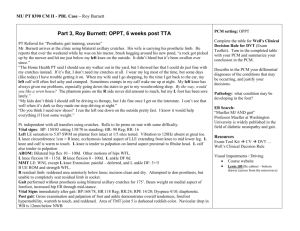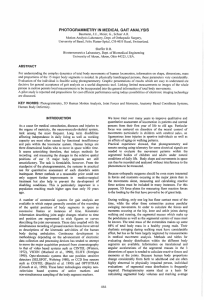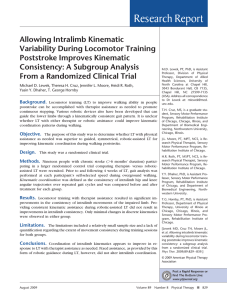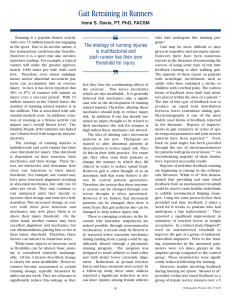KAdM - KNEEMO
advertisement
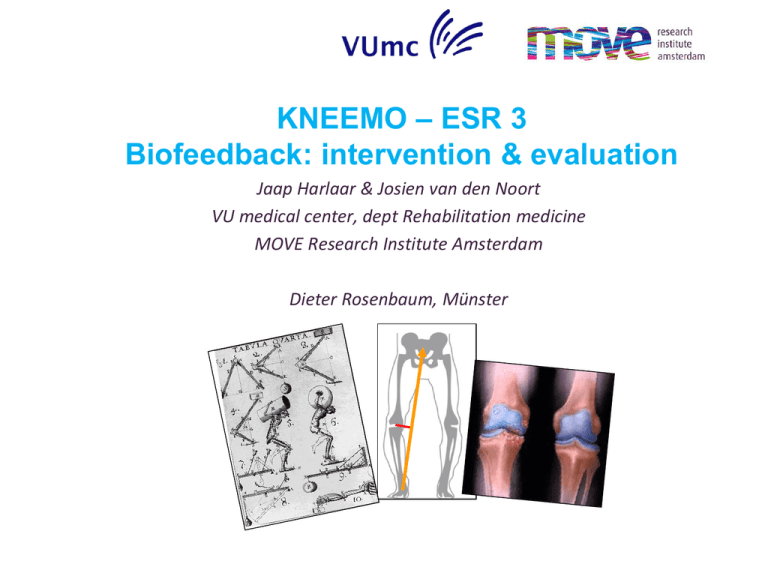
KNEEMO – ESR 3 Biofeedback: intervention & evaluation Jaap Harlaar & Josien van den Noort VU medical center, dept Rehabilitation medicine MOVE Research Institute Amsterdam Dieter Rosenbaum, Münster Department of Rehabilitation Medicine ... to make people walk better Clinical Gait Analysis ? Intervention Motion Capture in a gait lab > joint kinematics GroundReactionForce vector Quantifying Knee load: Measuring the Knee Adduction Moment Asymp Severe Knee OsteoArthritis 9 From Force to Tissue Stress 10 The simple case FMed = FGRF x (1 + RGRF / RBF) RBF = 0.09m FGRF FBF FGRF = 800N 2,5 Fmed (BW) 2 1,5 RKAdM 1 RBF 0,5 RGRF 12 11 10 9 8 7 6 5 4 3 2 1 0 0 Rgrf (cm) FMed KAdM = FGRF x RKAdM Lateral Medial Advanced Musculoskeletal modelling - Aim: precise quantitative data on: cartilage load intensity; location;and dynamics - alignment (> external load) + shape +cartilage properties + EMG (> muscle forces) cartilage loading KAdM is a proxy for Knee Load Asymp Severe Baliunas et al. 2002, Mundermann et al. 2005, Thorp et al. 2006, Rutherford et al. 2008, Foroughi et al. 2009 Kinematic strategies - To unload the knee Hunt et al. 2008, Simic et al. 2011, Shull et al. 2013, van den Noort et al. 2013 - E.g. toe-angle, trunk sway, step width, hip rotation - Effect on ground reaction force and knee position - Change knee adduction moment Normal Toe-in Trunk sway How gait modifications affect the KAdM Normal Toe-in Trunk sway van den Noort JC, Schaffers I, Snijders J, Harlaar J. The effectiveness of voluntary modifications of gait pattern to reduce the knee adduction moment. Hum Mov Sci. 2013 Jun;32(3):412-24 Toe-Out Role of visual feedback? - May be effective for gait retraining Barrios et al. 2010, Hunt et al. 2010, Shull et al. 2011, Wheeler et al. 2011 Gait Analysis in an VR environment Overground gait lab GRAIL by Questions 1. What is the most effective type of feedback to reduce knee load? 2. What is the best feedback parameter ? GRAIL - Gait Real-time Analysis Interactive Lab - Virtual environment with visual feedback - Motion capture system (Vicon) - Dual-belt instrumented treadmill - 17 healthy subjects 4 types of Feedback using 2 variables - Kinetic: Knee adduction moment - Kinematic: Hip internal rotation (promotes toeing in) - Four feedback types KAdM feedback - Decrease KAdM: - Bar 55% Polar 56% Color 53% Graph 49% - Different types feedback: - No effect Hip angle feedback - Increase hip endorotation - Bar 9o Polar 10o Color 8o Graph 7o - Different types feedback: - No effect Hip angle feedback - However… KAdM did not decrease significantly with increased hip endorotation Conclusion - Real-time visual feedback effective to modify gait - ↓KAdM - ↑hip endorotation - Feedback type made no difference - To lower the KAdM, direct but implicit feedback is more effective than indirect (but explicit) kinematic feedback How to proceed in ESR 3 ? Part1 - What are kinematic strategies used in lowering KAdM ? - Will KOA patients perform alike ? - Do their kinematic strategies differ from healthy ? Part 2 - Will this training sustain ? - Or is permanent feedback needed ? - >> wearable sensors – ESR11 - based on personalized kinematic strategy & tactile feedback - Does it promote functional gain ? - Does it decelerate joint status decline ? Discussion – part 2 - Training intensity Training frequency Evaluation Period outcome measures - KAdM - Functional Gain - .. - pitfalls ? KadM feedback to modify gait in KOA A promising approach ? Knee instability Fitzgerald et al. 2004, Lewek et al. 2005, Felson et al. 2007, Schmitt et al. 2008 A measure of stability.. - Definition stability to maintain a position or control movement under differing external loads Schipplein and Andriacchi 1991 - Via active neuromuscular system & passive restraint - Joint laxity - No relation with self-reported instability Schmitt et al. 2008 - Not dynamic or functional - Varus-valgus motion van der Esch et al. 2008 - Not related to muscle strength, joint proprioception, joint laxity and skeletal alignment Mechanical measure of stability Gait sensitivity norm (robotics) Hobbelen and Wisse 2008 Knie Flexie Hoek [graden] 100 80 60 40 20 0 0 100 200 300 400 Gangcyclus [%] 500 600 700 Knie Flexie Hoek [graden] 100 80 60 40 20 0 0 100 200 300 400 Gangcyclus [%] 500 600 700

